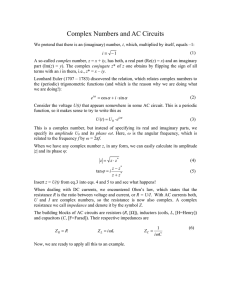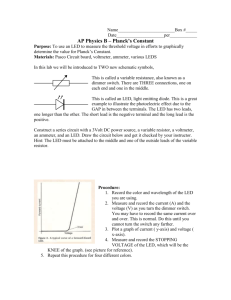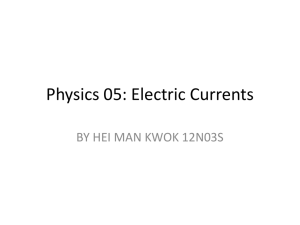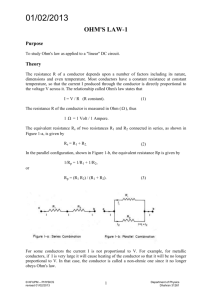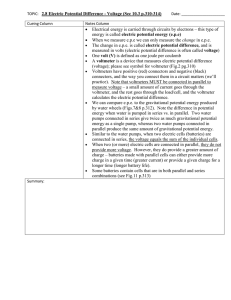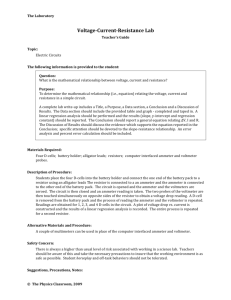LectureB
advertisement
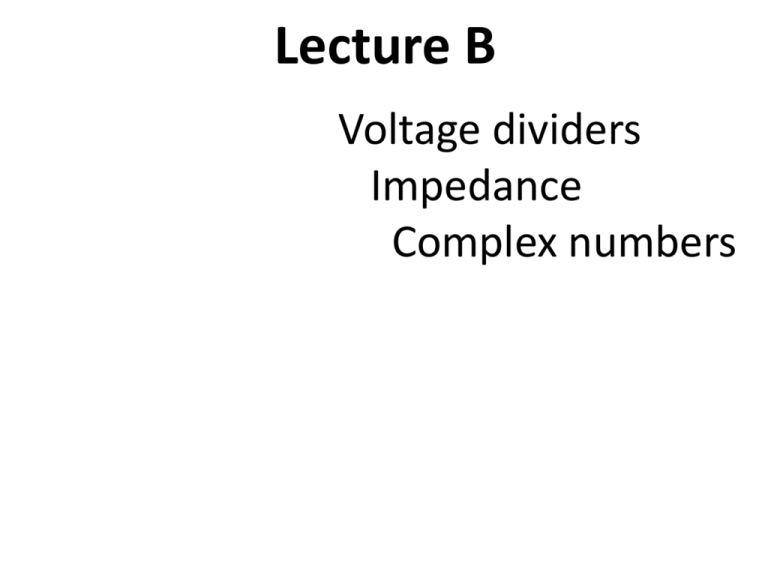
Lecture B Voltage dividers Impedance Complex numbers Lecture B Voltage dividers Impedance Complex numbers B1a 5W I3 What is I3? A) 2 A B) 4 A C) 5 A D) 10 A E) 14.5 A 4W 1W + 10 V B1b 5W I3 = 2 A What is IBatt? A) 2 A B) 4 A C) 5 A D) 10 A E) 14.5 A 4W 1W + 10 V IBatt = ? B2 What is Vout/Vin? R1 A) R1 R2 R2 D) R1 R2 B) R1 R2 E) C) R1 R2 R2 R1 R2 Things you need to know about complex numbers for Phys3330 1.Perform algebraic operations on complex numbers and represent a given complex number graphically and express it in polar form. 2. Represent a sinusoidal function as the real and imaginary part of an exponential and use this representation for adding trigonometric functions. 3. Set up a linear differential equation to describe the behavior of LCR circuit that is subject to an applied sinusoidal voltage. 4. Use complex exponentials to solve homogenous and inhomogeneous linear differential equations with constant coefficients. 1. Complex number - The imaginary unit: General complex number real part of z, x= Re z and , where x & y are REAL numbers imaginary part of z, y= Im z Arithmetic with complex numbers z1,2: + − × ÷ 1 Complex conjugate (z → z*) : Replace i with -i → → the modulus of z 2. Power Series for exponential and trigonometric functions: Euler’s Formula Now compare trigonometric and hyperbolic function in complex number: 3. Polar representation of a complex number z=x+iy y (imaginary) Representing z=x+iy by the point (x,y) z=x+iy Then, r ϕ x (real) where, So we can always write x y ✵Polar representation is advantageous for multiplication and division! Let then B3 L R What is Zeq? 1 1 A) R j L D) R 1 1 B) R j L 1 j L 1 C) R j L 1 E) R j L 1 Aliasing Red = real signal Blue = scope display Black points = sampling times B4 Is it possible to measure the current generated by the power supply using the scope? A) No, it only measures voltage B) Yes, just turn the knob on the scope from “V” to “I” C) Yes, put a resistor in the circuit and measure the voltage across it. B5 To measure the current thru resistor 3, how should the ammeter be attached? a) d) 1 A 3 A A 4 A b) 12 V 2 c) e) MORE than one of these choices is ok. B6 An ideal ammeter should have A) Zero resistance B) Infinite resistance C) A well defined resistance > A) 0W (e.g. 1W or 1kW) D) Shiny red color B7 To measure the voltage across resistor 3, how should the voltmeter be attached (assume you only attach one at a time)? a) d) 1 V 3 V V 4 V b) 12 V 2 c) e) MORE than one of these choices is ok. B8 An ideal voltmeter should have A) B) C) D) Zero resistance Infinite resistance A well defined resistance >0W (e.g. 1W or 1kW) Shiny red color


